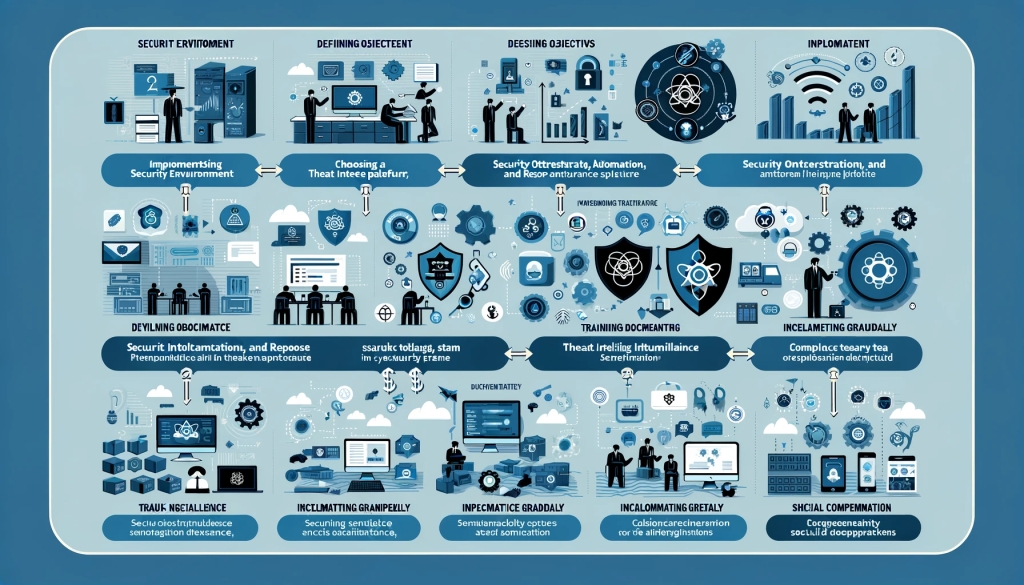
2024-2-16 23:45:26 Author: krypt3ia.wordpress.com(查看原文) 阅读量:20 收藏
This post was created in tandem between Scot Terban and the ICEBREAKER Intel Analyst, created and trained by Scot Terban.
Creating and implementing a Security Orchestration, Automation, and Response (SOAR) solution within your threat intelligence practices is a strategic process that enhances your cybersecurity posture by streamlining operations, automating routine tasks, and enabling a more effective response to incidents. Here’s a step-by-step tutorial on best practices for effectively integrating SOAR into your threat intelligence operations:
Understanding SOAR in Threat Intelligence
- Definition: SOAR refers to technologies that enable organizations to collect data about security threats from multiple sources and automate responses to low-level security events.
- Purpose: The main goal of SOAR is to improve the efficiency of security operations by automating complex processes of detection, investigation, and remediation.
Best Practices for Implementing SOAR
Assess Your Security Environment
- Identify Needs: Assess your current security posture and identify the areas where automation and orchestration can bring the most value.
- Resource Inventory: Take stock of your existing security tools and systems to understand how they can integrate with a SOAR solution.
Address Financial Concerns: Best Practices for Implementing SOAR
CostBenefit Analysis
Initial Costs vs. Longterm Savings: Evaluate the initial investment required for the SOAR platform against the potential longterm savings in terms of reduced response times, decreased need for manual intervention, and prevention of breaches.
ROI Estimation: Estimate the Return on Investment (ROI) by calculating the potential cost savings from automating responses and the efficiency gains in your security operations.
Budget Planning
Budget Allocation: Allocate a specific budget for the SOAR implementation, taking into account not only the cost of the software but also the training, integration, and potential customization expenses.
Cost Transparency: Ensure transparency regarding the costs associated with implementing and maintaining the SOAR platform. This includes licensing fees, support and maintenance costs, and any additional investments in hardware or infrastructure upgrades.
Funding and Financial Support
Explore Funding Options: Investigate potential funding options or financial incentives that may be available for enhancing cybersecurity postures, such as government grants for critical infrastructure protection.
Vendor Financing: Some SOAR vendors may offer financing options or flexible payment plans to help spread out the costs over time.
Cost Optimization Strategies
Optimize Existing Tools: Ensure that the SOAR platform leverages and optimizes your existing security investments by integrating with current tools and enhancing their capabilities.
Selective Automation: Prioritize automation of highvolume, lowcomplexity tasks to achieve quick wins and immediate cost efficiencies. Gradually expand to more complex processes as you gain confidence and experience.
Managing Operational Costs
Streamline Operations: Use SOAR to streamline security operations and reduce the need for additional personnel by automating routine tasks and freeing up analysts to focus on more strategic activities.
Efficiency Gains: Measure efficiency gains in terms of reduced mean time to detect (MTTD) and mean time to respond (MTTR) to incidents. These metrics directly correlate with operational cost savings and improved security posture.
Continuous Financial Review
Regular Financial Reviews: Conduct regular reviews of the financial impact of your SOAR implementation to ensure that it continues to deliver value and justify its cost.
Adjustment and Scalability: Be prepared to adjust your strategy based on financial performance and scalability needs. As your organization grows, your SOAR solution should adapt to changing financial and security requirements.
By addressing financial concerns through careful planning, cost benefit analysis, and ongoing management, organizations can effectively implement SOAR solutions that offer significant operational efficiencies and cost savings. Balancing the upfront investment against the potential for Longterm savings and improved security posture is key to achieving a successful SOAR implementation.
Define Clear Objectives
- Set Goals: Determine what you want to achieve with SOAR, such as reducing response times, automating repetitive tasks, or consolidating security alerts.
- KPIs and Metrics: Establish Key Performance Indicators (KPIs) to measure the effectiveness of your SOAR implementation.
Choose the Right SOAR Platform
- Compatibility: Ensure the SOAR platform is compatible with your existing security infrastructure.
- Scalability: Select a platform that can scale as your security needs grow.
Develop and Test Playbooks
- Create Playbooks: Develop automated workflows (playbooks) for common security scenarios in your organization.
- Testing: Regularly test and update the playbooks to ensure they work effectively and cover all necessary scenarios.
Integrate Threat Intelligence
- Data Sources: Integrate various threat intelligence feeds into your SOAR platform to enrich incident data and improve decision-making.
- Contextualization: Use SOAR to contextualize and prioritize threats based on your specific environment and risk profile.
Train Your Team
- Skill Development: Ensure your security team is trained to use the SOAR platform effectively.
- Continuous Learning: Encourage ongoing learning and adaptation as threat landscapes evolve and new SOAR capabilities emerge.
Implement Gradually and Review
- Phased Approach: Start with automating simple, low-risk tasks and gradually move to more complex processes.
- Regular Reviews: Continuously review the performance and impact of SOAR in your security operations and make adjustments as needed.
Ensure Compliance and Documentation
- Regulatory Compliance: Make sure your SOAR implementation complies with relevant legal and regulatory requirements.
- Documentation: Maintain thorough documentation of SOAR processes, playbooks, and incidents for accountability and continuous improvement.
Implementing SOAR in your threat intelligence practices is a strategic process that requires careful planning, integration, and continuous refinement. By following these best practices, you can enhance your organization’s ability to quickly and effectively respond to security threats.
如有侵权请联系:admin#unsafe.sh
